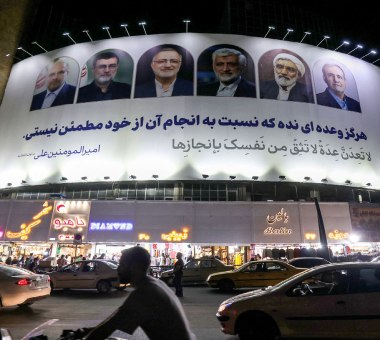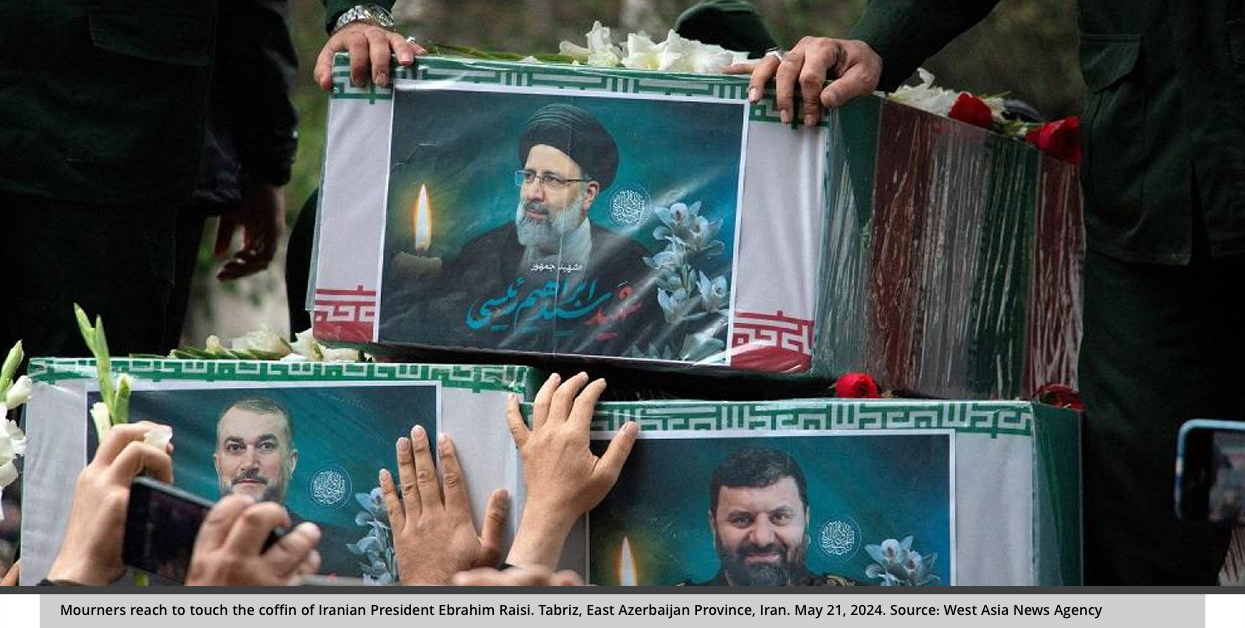Perceptions of Iran’s Political Scene in Upcoming Presidential Election
The upcoming presidential election in Iran is of particular importance given the internal and external issues surrounding Iranian politics. Foremost among them is the question of who will succeed Supreme Leader Ali Khamenei, how will his vision—and the next president’s—shape Iran’s political system 80 years after the 1978–1979 revolution, and how will regional and international developments and their implications affect Iran’s security and diplomatic policies.
by STRATEGIECS Team
- Release Date – Jun 24, 2024

The Iranian presidential election on June 28 following the sudden death of President Ebrahim Raisi and several top officials in a May 19 helicopter crash is considered an exceptional event. The contours of the presidential race became clear after the 12-member Guardian Council announced June 6 that it had approved the eligibility of six candidates out of the 80 who had declared their intention to run.
These elections hold particular significance in light of the internal and external issues surrounding Iranian politics, foremost among them being the question of who will succeed Supreme Leader Ali Khamenei, the critical vision for the shape of the Iranian political system 80 years after the 1978–revolution, and regional and international developments and their implications for Iran’s security and diplomatic policies.
Reading the Guardian Council Decision
The Guardian Council approved six candidates, five of whom belong to the conservative faction—Saeed Jalili, Alireza Zakani, Seyyed Amir-Hossein Ghazizadeh Hashemi, Mostafa Pourmohammadi, and Mohammad Bagher Ghalibaf—and one candidate from the reformist faction, Masoud Pezeshkian, who was nominated by acclamation. The council excluded prominent figures, including former President Mahmoud Ahmadinejad and former Speaker of the Parliament Ali Larijani.
In fact, the tendencies of the Guardian Council in selecting candidates for the upcoming election, as well as its roles in previous presidential elections, reveal its expanding role in bolstering the conservative faction and restricting reformists. Numerous reports and analyses have indicated its increasing influence in the electoral landscape by following a policy of excluding candidates who oppose the Supreme Leader’s choices and enhancing the chances of his allies to reach the presidency.
In the February 2020 parliamentary elections, for instance, the council excluded several reformist candidates as well as those within the conservative faction who were critical of it. In the 2021 presidential election, the council approved seven applications out of 500 candidacy requests, excluding prominent figures such as Ahmadinejad, Larijani, and former Vice President Eshaq Jahangiri.
Based on this, the council’s decisions can be seen as an expression of the Supreme Leader’s relatively new orientations, which have become characterized by a limited tolerance for dissent regarding domestic and foreign policy issues. Although Ahmadinejad was Khamenei’s preferred choice in the 2009 election, his increasingly critical stance eventually led to him to be viewed as outside the ruling faction. The same applies to Larijani, who was considered for years to be close to Khamenei and who chaired the parliament for three terms.
The Iranian Political Scene Ahead of the Election
The decisions of the Guardian Council reveal the political considerations of the Supreme Leader and the ruling establishment in Iran, making this election a significant event. Key among these considerations are the necessity to reduce conflicts between political factions and to achieve unity and coherence within the ruling system and state institutions, especially in anticipation of the succession of the Supreme Leader. This is particularly crucial given Khamenei’s declining health and advancing age of 85.
Maintaining the stability of the Iranian system despite conflicts between reformist and conservative factions, and minimizing the impact of regional conditions—especially with the escalation in the region since the outbreak of the war in Gaza, in which Iran is heavily involved through its proxies—are essential goals.
This is underscored by Khamenei’s call for the next president to be “committed to the principles and foundations of the revolution” and to “continue what President Raisi started.” Additionally, the Supreme Leader’s military advisor, Gen. Yahya Rahim-Safavi, urged Iranians to elect a president who “does not speak contrary to the Supreme Leader,” but rather “considers himself the second-in-command.”

The election is also linked to the future direction of Iran’s domestic and foreign policies, especially in light of the Iranian economic crisis and its connection to the nuclear negotiations with the United States. The candidates’ positions vary between the necessity to continue aligning economic structures with U.S. sanctions, as was Raisi’s approach, and returning to negotiations with Washington to ease current economic pressures, as preferred by the reformists.
Additionally, Iran’s regional practices and its ongoing plans to secure its sphere of influence in the region are significant. While these plans are directly overseen by the Supreme Leader and executed by his Islamic Revolutionary Guard Corps, many former Iranian presidents and foreign ministers have expressed opposition to this direction. Even though the president’s role may not be to set policies, his office is responsible for implementing them, which means whomever becomes president has the ability to place numerous obstacles and restrictions onto the implementation process.
Will the Election Change the Existing Political Equation?
Raisi managed to achieve harmony and stability within Iran’s ruling system. His sudden death came at a crucial regional geopolitical moment, causing renewed disputes within the Iranian elite, notably between conservatives and reformists, and among conservatives themselves. As a result, the Supreme Leader’s expectations for the upcoming elections face several challenges.
First: The Victory of the Reformist Candidate
A possible victory for Masoud Bazargan as president will pose a challenge both to Khamenei’s plans and Iran’s overall political system, especially given the conservatives’ control over the parliament and the Guardian Council. Despite the 5-to-1 predominance of conservative candidates, this does not diminish the scenario of the reformist candidate winning. This is particularly true if voter turnout is high and the reformist movement demonstrates an ability to mobilize and rally support. Additionally, a potential runoff election could further enhance Bazargan’s chances.
According to a survey published by Vatan Emrooz newspaper, Bazargan secured 29% of the polled votes, compared to 25.2% for Mohammad Bagner Qalibaf and 24.1% for Jalili. On the other hand, the reformists have rallied around their candidate, ensuring unity and avoiding vote splitting. Current candidate endorsements include former President Mohammad Khatami and former Vice President Jahangiri, under the patronage of Hassan Rouhani’s administration.
Conversely, the conservative faction continues to strive for consensus around a single candidate, which could impact the chances of either Qalibaf or Jalili, who are the most favored among conservatives. Qalibaf has called for conservative candidates to withdraw in favor of supporting one candidate.
Lastly, observers of Iran’s presidential electoral behavior note a pattern of power alternation between conservatives and reformists: from conservative Ali Akbar Hashemi Rafsanjani succeeding reformist Khatami, followed by conservative Ahmadinejad succeeding reformist Hassan Rouhani, and now potentially returning to a reformist presidency after conservative Raisi’s tenure.
Second: The Decrease in Voter Turnout
The decrease in voter turnout favors the conservative faction, indicating a reluctance among reformists to participate and vote. However, the regime needs a high voter turnout to demonstrate popular support and to grant legitimacy to the next president. There are possibilities that the elections could witness the succession of the current Supreme Leader or that the next president might himself become the next Supreme Leader.
It’s worth noting that the presidential elections in 2021 recorded the lowest turnout in its history—48.8%. Opinion polls reveal a significant apathy towards this election. According to a June 23 survey conducted by Gamaan, a non-profit research foundation in the Netherlands dedicated to analyzing and measuring attitudes in Iran, more than 65% of Iranians will not participate in the presidential election. Additionally, a survey by the Iranian Student Polling Agency (ISPA) revealed that more than 73% of Iranians did not watch the debate.

Third: The Worsening Disagreements Among Conservatives
Khamenei’s strategy to achieve cohesion within the governance system focuses on the conservatives in control of the state institutions and excluding various ideological factions from assuming high positions. However, disagreements within the conservative camp itself are highly likely, driven not by ideological or nationalist reasons but rather by personal interests and individual gains. Many of them realize that Raisi’s death has reopened debates over who will succeed the Supreme Leader, leading to escalating competition within the conservative circles to quickly present acceptable alternatives.
On the other hand, the election may reveal broader rifts within the conservative camp, particularly between its competing poles, Qalibaf and Jalili. Qalibaf holds high stature within conservative forces and parliamentarians, while Jalili commands a popular voting base that surpasses Qalibaf’s. Furthermore, the Supreme Leader fears the rise of a conservative figure who has knowledge of the Iranian system and enjoys loyalty within the elite. He is concerned that such a person might attempt to undermine his control over the governance apparatus. This concern was evident during the tenures of Rafsanjani and Ahmadinejad, both of whom demonstrated an ability to carve out independent spaces in their presidencies despite being conservatives.
From this perspective, Khamenei’s preference for any prominent candidate within the conservative camp can be interpreted, as he limits his overt support, unlike the open and genuine backing he offered Raisi during his presidential candidacy.
Fourth: Post-Election Disturbances
The possibility of the reformist camp resorting to street protests once again to challenge the election results or accuse the state of rigging them is plausible, similar to the events of 2009. These protests, known as the Green Movement, erupted in response to Ahmadinejad’s declared victory over reformist candidate Mir Hossein Mousavi and persisted for months. The underlying causes of intellectual, economic, and anti-regime grievances have continued since the 2022 backlash of protests following the death of Mahsa Amini, a young woman who died in police custody shortly after being accused of violating Iran’s Islamic dress code for women.
Fifth: An Inability to Fill the Gap Left by Raisi’s Death
Raisi was Khamenei’s favorite political figure primarily because he was completely loyal to the Supreme Leader, his progression through various important state positions, and his reputation as a religious leader. His wide range of experience allowed Raisi to deftly manage both domestic and foreign affairs. However, none of this year’s candidates possess such a broad range of multi-sectoral experience.
They either come from the Revolutionary Guards and veterans (Jalili and Ghalibaf); civil service and parliamentary backgrounds (Zakani and Ghazizadeh Hashemi); law enforcement and judiciary (Pourmohammadi); or are closer to technocrats (Masoud Pezeshkian, who served as health minister during Khatami’s tenure).
Conclusion
During the June 19 debate, it was evident that the candidates lacked comprehensive election campaigns or in-depth political and economic discussions. Consequently, the debate did not garner significant interests, substantive discussion, or even extensive discourse regarding the candidates’ views.

STRATEGIECS Team
Policy Analysis Team
 العربية
العربية